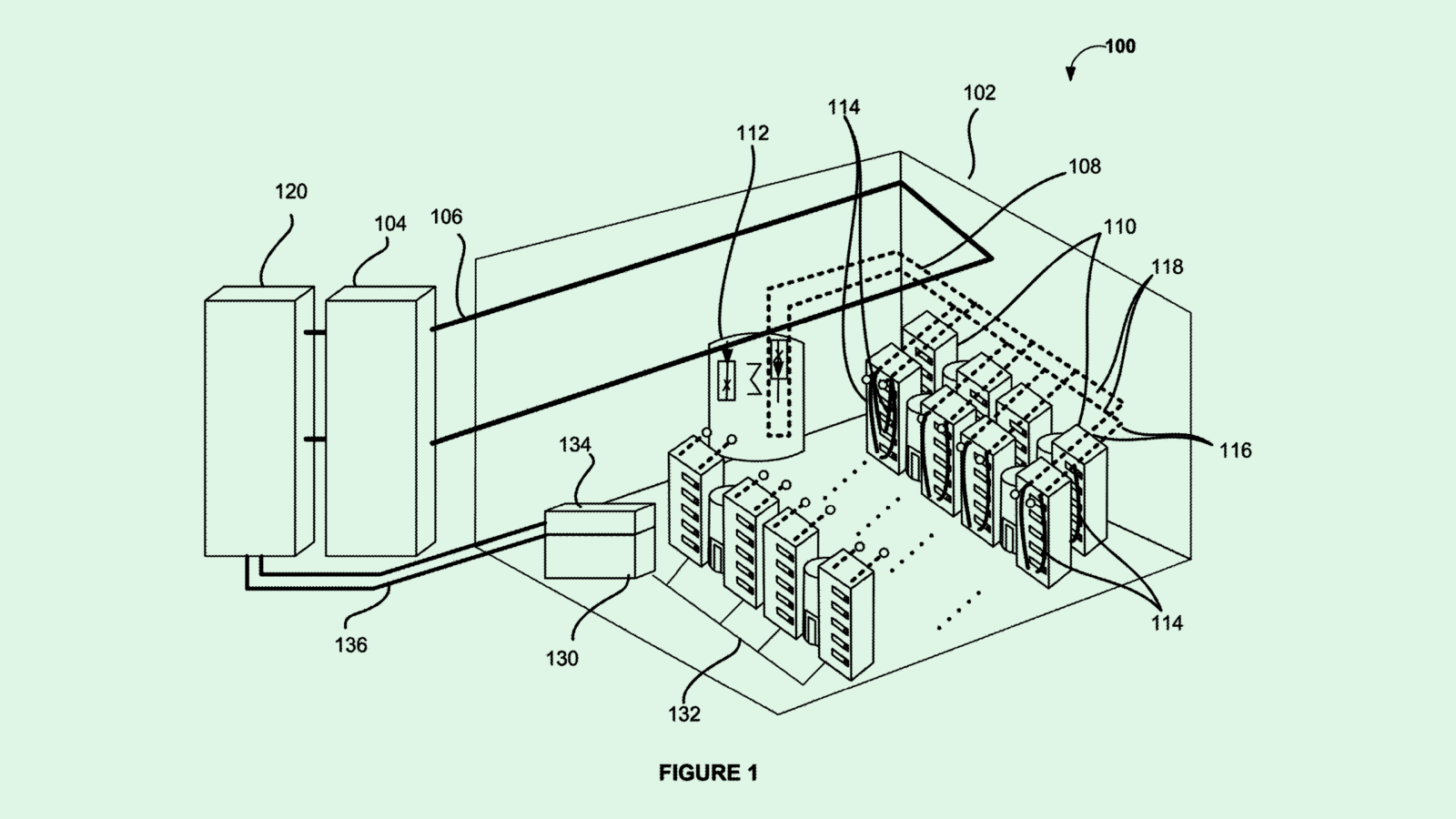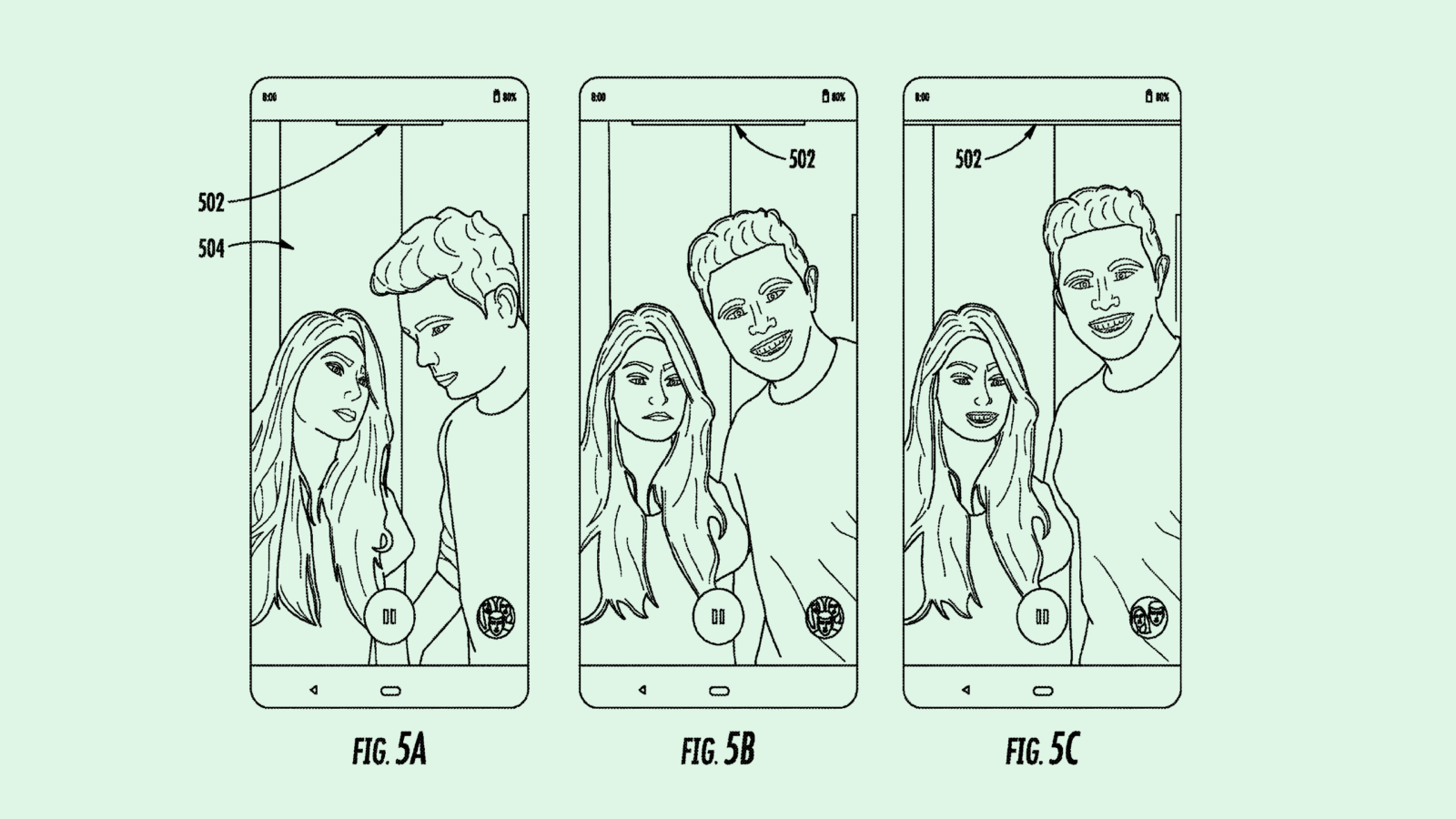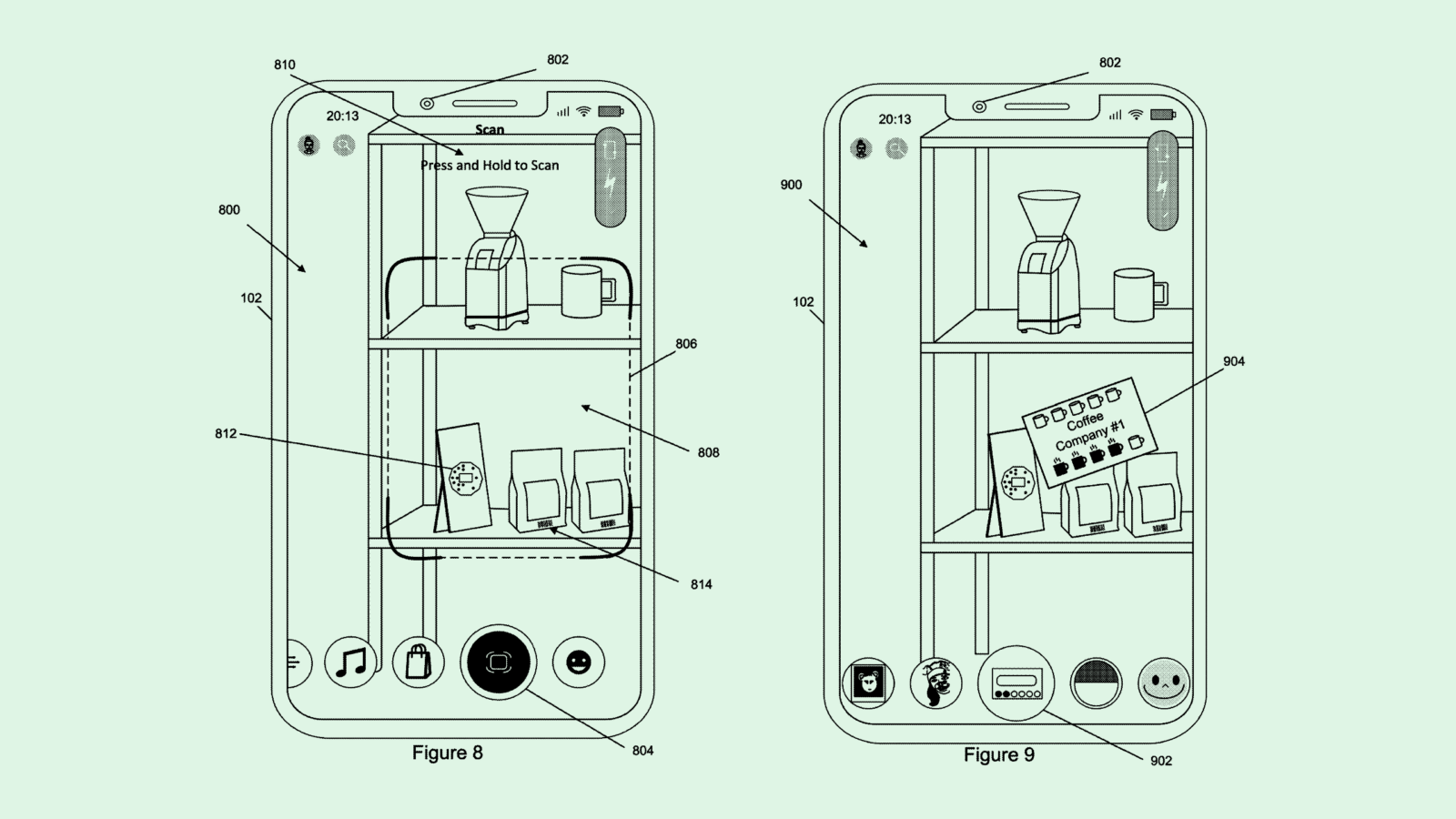Happy Thursday and welcome to Patent Drop!
Today, a patent from Nvidia to reel in data centers’ environmental impact could signal that the company is reading the tea leaves on data center architecture. Plus: Google wants you to smile for the camera, and Snap wants to track when you check out.
But first, a quick programming note: The next Patent Drop will be published on Tuesday, Sept. 3, in observance of Labor Day. Our Tuesday edition will be a special report exploring the world of consumer tech wearables.
Let’s dive right in.
Nvidia’s Ice Box
As Nvidia’s AI race continues to heat up, the company is looking at ways to cool things down.
The chip giant filed a patent application for “energy efficient liquid-cooled datacenters.” Nvidia’s tech essentially aims to cool down data centers without sucking up tons of power.
Cooling takes up an estimated 40% of energy consumption within a data center. “The need for significant electrical power prevents installation in locations where such power may not be available, and may not align with environmental rules or targets for operation,” Nvidia said in the filing.
Fuel cells, fed with “natural gas or bio-gas” such as hydrogen, convert chemical energy from this gas into electricity to either power the entire data center or supplement electrical power “using a supply of relatively environmentally or ‘green’ power.”
As the fuel cell generates electricity, the waste heat it gives off is captured using a “heat exchanger,” which transfers that heat to what the filing calls an “absorption chiller.” This device is used to produce “cooled liquid, air, or gas,” and, instead of using electricity, utilizes the collected waste heat in this process. The coolant created in this process is thereby used to cool down the electrical components of the data center.
In utilizing natural gas like hydrogen for fuel cells, and reusing waste heat in place of electricity, Nvidia’s tech provides two potential methods to make data centers a little less environmentally damaging.

We’ve seen patents like these from Nvidia before: The company has previously sought to patent “intelligent data center” architecture that allows server racks to adapt to changing demands in power, as well as a way to power down “idle cores” within these facilities.
Data centers currently account for between 1% and 2% of overall global power consumption, but could increase to between 3% and 4% by the end of the decade, according to Goldman Sachs Research. The firm projects power demand by these facilities to grow 160% by 2030.
This power demand has led some tech firms to downplay their greenhouse gas emissions and seek workarounds to the carbon credits system. These patents signal that tech firms may be looking for more ways to cope with that ever-growing power demand — especially as AI fever continues to skyrocket.
“It’s really thought leadership on showing what a data center is going to look like in 10 years,” said Trevor Morgan, senior vice president of operations at OpenDrives. “What is going to be the ideal way to build and maintain – in a sustainable way – a data center?”
Nvidia continues to be the powerhouse of the AI industry: The company reported quarterly revenue of $30 billion on Wednesday, up 122% year-over-year. Its data center revenue hit an eye-popping $26.3 billion, up 154% from the prior year. The company’s stock still tumbled after the report, potentially because some buy-side analysts were too bullish about it’s earnings projections.
Sustaining this level of growth may be difficult if power supplies can’t keep up, said Romeo Alvarez, director and research analyst at William O’Neil. “Not having enough electricity supply for data centers, and maybe even limiting [data centers’] capacity … they may see that as a limiting factor for their growth,” said Alvarez.
Another factor that would impact earnings, Morgan said, is “missing out on advances in data center architecture and not being able to dictate how different components, different aspects of the infrastructure evolve.” He added that “they want to ensure that they are part of whatever evolution is going to happen.”
Google’s AI Snapshot
Google wants to help you get the perfect shot.
The company filed a patent application for methods of “providing feedback for artificial intelligence-based image capture devices.” Google’s tech essentially embeds real-time AI-powered image analysis into smartphone or tablet cameras to help users take better photos.
Google noted that taking self portraits or group photos can be difficult, even with selfie cameras and delay timers. “This can result in the captured image having suboptimal lighting effects and/or other undesirable image properties,” Google said.
Within a viewfinder, a group of machine learning models — including facial, pose, and expression-detection models — perform analysis on the image data before it’s actually captured in a photo. This analysis helps it come up with a “respective image quality indicator” that determines whether or not the frame “satisfies a photographic goal.”
The frame may be judged on qualities such as lighting, blur, composition, or even the expression of the person being photographed. From this analysis, Google’s system would provide feedback to the user to help fix the photo.
For example, some suggestions may include “hold the camera still,” “there’s not enough light,” “I don’t see any faces,” “try a different expression,” or “move camera farther away,” the filing noted. “The suggestions can be descriptive of a primary reason why the artificial intelligence is not capturing an image or otherwise providing the image with a relatively lower score.”
Once those are satisfied, Google’s tech may automatically capture the photo itself.

Though enterprise use cases for AI may stand to be a bit more lucrative than helping users take the perfect photo, AI tools like these normalize the tech for the average consumer, said Bob Rogers, Ph.D., the co-founder of BeeKeeperAI and CEO of Oii.ai. Doing so opens the floodgates for a far larger market than just tech professionals.
“It creates a very nice entry into introducing AI technology that might then spread into other areas,” said Rogers. “There’s probably a push to make AI feel natural to people.”
This isn’t the first time we’ve seen Google aim to beef up its image tools with AI. The company launched a suite of tools called Magic Editor last year, and recently announced an AI photo editing tool on the Google Pixel 9 called “Reimagine,” which uses a generative model to make convincing (and outlandish) edits and changes to images, including adding car wrecks and drug paraphernalia, according to The Verge.
“At times, some prompts can challenge these tools’ guardrails and we remain committed to continually enhancing and refining the safeguards we have in place,” Google spokesperson Alex Moriconi told The Verge.
Though guardrails may help prevent people from creating some risky and dangerous imagery, there has yet to be a real solution for the problem of hallucination — an issue Google’s Gemini image generator faced backlash for earlier this year. However, by introducing these tools to a broader audience, the company could gain access to “millions of sources of feedback” that’ll go a long way in tightening up the models, said Rogers.
“[AI models] rely on feedback to very quickly adapt algorithms to improve and sharpen their accuracy,” said Rogers. “If millions of people are using something, and respond one out of every thousand times — especially when it’s an egregious error — you’re going to eventually get a lot of data on the things that matter most.”
Snap Tracks Deals
Snap may be getting into couponing.
The company filed a patent application for augmented-reality content items to “track user activity and redeem promotions.” As the title implies, this tech helps Snap track user behaviors over time to determine when they may be missing out on deals, using AR as a means of in-app, interactive tracking.
“Existing systems typically do not implement augmented reality content to indicate purchases of products by users of client applications or to redeem promotions related to products based on the number of purchases of the products,” Snap said in the filing.
Snap’s patent tracks when users interact with specific products or are in specific locations that are tied to promotions through that user’s camera. It may rely on identifiers such as barcodes or QR codes scanned or photographed by the user in the Snapchat app, or use location data. Snap’s system would use AR to keep track of this.
These activities are tracked over time as the user continues to report their purchases on Snap. For example, if a user frequents a certain coffee shop and takes a photo of their coffee each time, it may determine that they have redeemable rewards from their purchases.

AR has long been a big part of Snap’s content and ad strategy, largely by offering sponsored AR lenses to advertisers, said Mithru Vigneshwara, product director at AR experiences company QReal.io. Snap touted in an April earnings call that, on average, more than 300 million people engage with its AR offerings every day.
But the company has had a rocky road with some of its AR bets: It shuttered its enterprise AR services unit last September just six months after launch. CEO Evan Spiegel told employees that business performance has “reduced our capacity to invest in this incremental opportunity.”
However, the market for AR may be changing: Meta announced earlier this week that it is shutting down its Spark AR Studio platform, which enabled creators and brands to build their own AR effects. The company noted that it’s “shifting resources to the next generation of experiences, across new form factors like glasses.”
This could mean two things for Snap, said Vigneshwara. For one, Meta’s decision takes one major player out of the market, allowing Snap to “eat into that market share,” he said. “But at the same time, you could also read that and say, ‘If Meta is pulling back on this, there might be something happening in the industry where they don’t see as much ROI on this.’”
Extra Drops
- eBay wants to make it easier for you to sell your whole closet. The company filed a patent application for automatic listing generation for multiple items.
- JPMorgan wants to make cybersecurity easy. The financial institution filed a patent application for a service that “simplifies network cyber defense capabilities.”
- Shopify wants to get you the perfect shot. The company wants to patent a system for “providing product image recommendations.”
What Else is New?
- OpenAI and Anthropic are working with the U.S. government to evaluate their AI models for safety.
- Apple’s has added another AI feature to its iOS 18.1 developer betas called Clean Up, which allows you to remove objects from photos.
- Uber is investing in autonomous driving software firm Wayve, adding another deal to its several partnerships for self-driving technology.
Patent Drop is written by Nat Rubio-Licht. You can find them on Twitter @natrubio__.
Patent Drop is a publication of The Daily Upside. For any questions or comments, feel free to contact us at patentdrop@thedailyupside.com.
